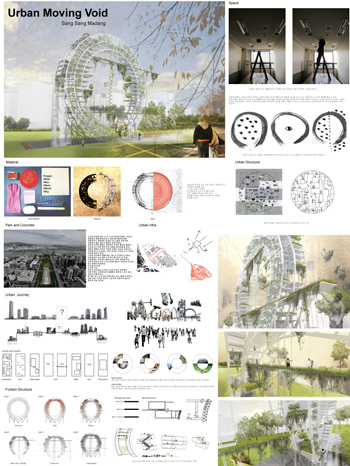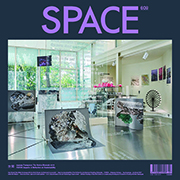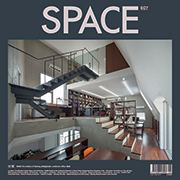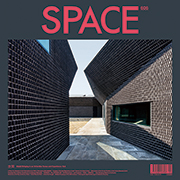The 29th Space Prize for International Students of Architecture Design
- Social Imagination -
SUBJECT
Social Imagination
The award ceremony for the 29th Space Prize for International Students of Architectural Design and the opening ceremony for the award winners were held at the Space Theater in the Space Group Building on November 9. Prof. Yoongyoo Jang (School of Architecture, Kookmin University), who served as the single judge this year, brought up the subject of ‘Social Imagination,’ which he has sought after for a long time, as the theme of the competition. In the annotation, Prof. Jang says, Social Imagination goes through an interesting process of ‘inducing a pivotal reaction like the Oriental acupuncture and reorganizing the entire city.’ Social Imagination can induce us to ask fundamental questions about the existing city by taking a look at the city from a fresh point of view, and lead to the ‘formation of a new circulation system that induces environmental changes rather than aesthetic manipulations resulting in the restructuring of the city.’
The subject was explained at a presentation held last May. More students than ever attended the presentation with a view to figuring out the subject and direction of this competition, whose physical conditions and concrete programs were never presented. However, the number of participants, which used to exceed 700 teams, dwindled to 199 teams this year, less than 30% of last year’s participants. At the first open judgment held on October 26, the fresh works of 11 teams who ‘thought hard about healthy architecture’ competed with one another under a great deal of tension. Though satisfied with various suggestions, the judge said he was sorry that ‘generally speaking, the contestants had something to be desired in terms of implementation and completion of spatial density rather than in terms of their concentration on the subject.’ It is also in this context that no grand prize or best prize was chosen. He concluded the judging by asking all prize winners to keep improving their works after this competition, and turn them into something that can be actually applied to society. The prize-winning works were on display until November 15, and they will continue to be on display via online at the Space Grand Prize homepage. Now allow me to introduce the works of the 11 teams that won the excellent prizes and the special prizes.
JURY REPORT
Yoongyoo Jang
Professor of School of Architecture at Kookmin University,
Principal of UnsangDong Architects Cooperation,
Representative of Gallery Jungmiso
'Social Imagination', the theme of the Space Prize for International Students of Architectural Design, started from a question regarding how individual imagination can be usefully connected to society. The question was intended to allow exploration of the possibility of changing the present city and society by making the experimental and conceptual roles of architecture a social issue.
Social imagination begins with city research on rediscovering existing space structures or realizing new combinations of programs. The main evaluation point of city research that had to be reconciled for the assignment was a serial process of questioning and redefining the overall aspects of architecture, ranging from the concept of traditional urban space and the conceptual aspect of defining space, to physical elements, and turning such actions into interesting architectural proposals. It was aimed to see the manifestation of a procedure to turn an architectural concept into a process and develop the process, excluding formal research and just focusing on results.
Prize-winning programs need to develop a concept of imagination through city research and to contain various stories of how to build architectural displacement where a space in imagination becomes an actual space. What the competition intended was for participants to have interest in developing their programs into a system or an installation, which could lead to the change of the city, or in suggesting new urban programs, rather than simply organizing a beautiful form or constructing proportional space. Those awarded were selected because they were very experimental in light of the conceptuality of the theme, “Can interesting programs and systems be developed into an architectural device?” The most important point in the architectural proposals on an imaginative city is not just how participants set up a concept, but the detail in their programs, which are meant to heal and revive a city, and whether they worked hard enough to realize all the structures of new spatial exploration. Another important point was how to turn small but interesting architectural ideas into social imagination.
What is regrettable, however, is that in the competition, the overall programs ? including the awarded ? have a lower level of construction of spatial density as well as completeness, compared with the concentration on the theme. It is also in this context that no grand prize or best prize was chosen. The projects need to acquire a certain level of completeness that accommodates both imagination and the depth of actual application to society. As a tip for the next project, it should be noted that any trials to approach social systems with the concept of either vast programs or urban abstraction were mostly excluded, and therefore not selected for the Prize.
I would like to thank you all for your participation in the competition and for all your hard work and time spent on deliberating the social aspect of architecture and making various attempts for sound architecture.
Subject Description
Social Imagination
The time has come to praise imaginative architecture. We are obsessed with creating more novel and marvelous shapes and spaces, but as our imagination accelerates, it reveals its individualized limitations. Now, we try to replace the possibility of imagination with tools that can change cities and societies…we are looking forward to seeing new cities and architecture created by our social imagination.
Our modern society cannot be interpreted just through simple physical factors. It is a huge interrelated system, a complex network in which a change in one part causes a domino effect in other parts. People are no longer satisfied with the current architecture that focuses on creating spaces and forms; rather, they want an architectural vision that can redefine their urban environments and social contexts. In other words, they wish for architecture to combine the values of the society, city and humans and produce a cultural vessel that can hold all. However, like the tail of a coin, the enormous structures hidden behind social networks end up building more individualized and isolated territories. Societies based on consumption have grown apart from fundamental social issues under the pretext of a cultural life, thus incurring a phenomenon through which specific interests such as narrative styles, designs and atmospheres were ultimately created. This lack of sociality has resulted in numerous mistakes, even in imagination - a creative power that can produce the most essential of values.
Imagination is a matter of personal perception. It is a process of composing and accomplishing a unique world. As Blake once noted, imagination is not a peculiar state, but is rather about human existence itself and it requires creating something newby reflecting itself. The imaginary personal existence can be transformed into a creative framework to create communication and build social consensus. In other words, personalized imagination is further developed to serve as an element to change and reform society. At this critical moment, we are required to explore new methods to connect the spaces of architectural imagination with society through a ‘Social Imagination.’
I want to choose an infinite number of methods to respond to society and find its multi-faceted reactions, using the Social Imagination. The multi-faceted reactions refer to revitalizing the urban environment, industries, economy, culture, and so on, by providing declining cities with innovative programs and a physical architectural environment. Our cities require the composition of new circular systems, inducing a new environmental change rather than an aesthetic manipulation achieved through simple urban reconstruction. The Social Imagination possesses an interesting process that can withdraw a vital response, much as in oriental acupuncture, and reorganize entire urban settings. Like needles, it stimulates the architecture of the city to revive its energy, bringing the city back to life. It can also establish a totally different urban program via the newly inserted program, while keeping the stated urban order intact. It can transmit the possibility of new meanings to the city by acting as the tool to induce reactions between both the city and the environment.
The Social Imagination can play the role of developing urban infrastructure in a new manner - not the means of building the structure of the architecture itself; it can be related to questions pertaining to the consequences produced by the city; it can be compared to setting the criteria for drawing the roles and influences of the architectural spaces created by the combination of diverse urban factors. The social imaginary space can cross many boundaries and obtain the intense power to achieve an integrated city and architectural areas. I anticipate the arrival of a new imagination that can bring about the structures and spaces of new cities, one indispensable for interacting with the modern city life.
GRAND PRIZE
No Grand Prize & Best Prize
PRIZE OF EXCELLENCE
No Grand Prize & Best Prize
SPECIAL PRIZE
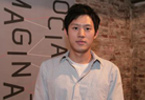
Jaehoon Oh
Korea University
Crane, Almighty
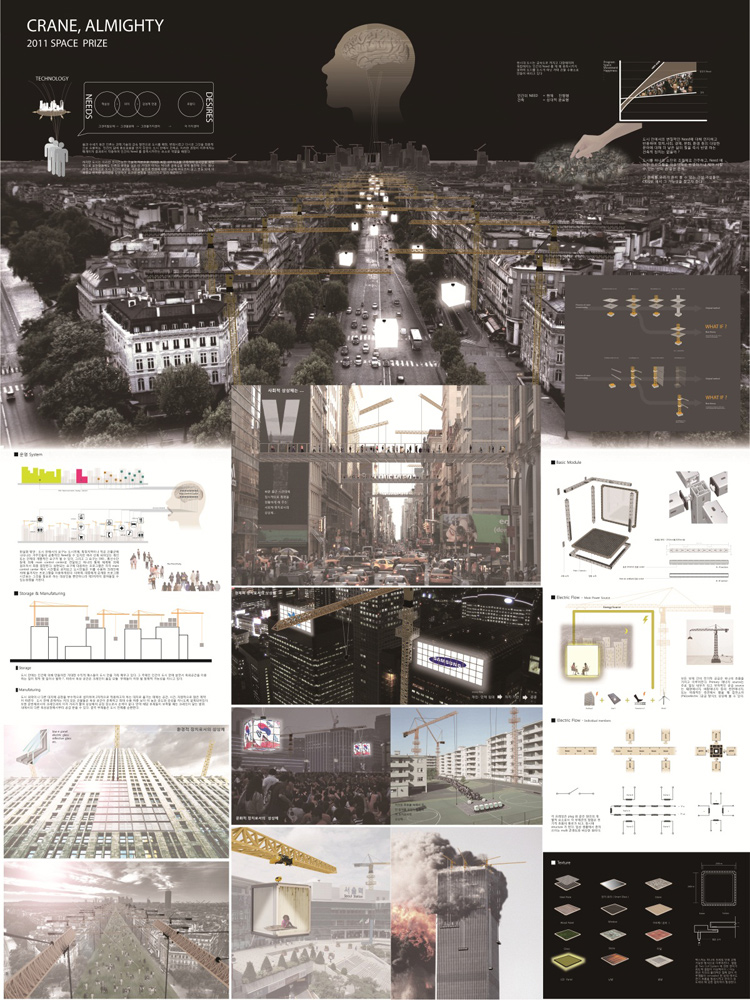 The sudden development of science and technology has allowed cities to expand and their inhabitants to live in newfound richness. Architecture has mediated this process. People inhabiting this architecture therefore have had a lot of chances to fulfill their needs within this system. People, however, have degenerated the meaning of “need,” wanting for more satisfaction from this competitive system. Today cities are overheated by the need to respond to human needs, which keep on growing and transforming. The main goal of city is fading out and the meaning of metropolis is continuously degrading into a “huge mass cage.” Could there be an architectural device that perceives the unstable human needs and immediately cures the problem in all of its aspects (social, political, economical, etc.)? We need to find an ideal solution, something like god’s hand, whose touch could become a remedy for the whole city… As an alternative, I would like to propose Crane, which has as many potential possibilities as the social imagination may allow.
The sudden development of science and technology has allowed cities to expand and their inhabitants to live in newfound richness. Architecture has mediated this process. People inhabiting this architecture therefore have had a lot of chances to fulfill their needs within this system. People, however, have degenerated the meaning of “need,” wanting for more satisfaction from this competitive system. Today cities are overheated by the need to respond to human needs, which keep on growing and transforming. The main goal of city is fading out and the meaning of metropolis is continuously degrading into a “huge mass cage.” Could there be an architectural device that perceives the unstable human needs and immediately cures the problem in all of its aspects (social, political, economical, etc.)? We need to find an ideal solution, something like god’s hand, whose touch could become a remedy for the whole city… As an alternative, I would like to propose Crane, which has as many potential possibilities as the social imagination may allow.
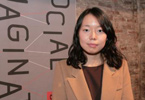
Yoojin Han
Seoul National University
Weave the Fabric
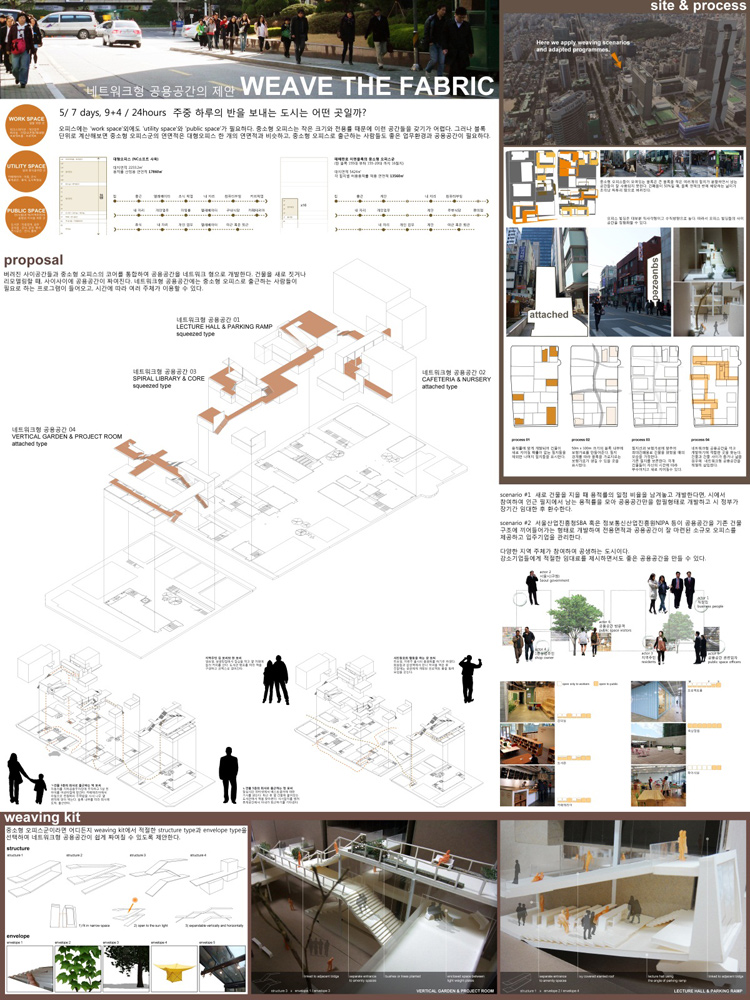 The office is a place where we spend more than half of our weekdays. The office needs utility space, public space, as well as working space. For small-to-medium offices, it is not easy to provide such spaces. However, if we calculate the total floor area of a small-to-medium office, by block, and that of one big office, we find that they are almost the same. Moreover, records show that the demand for small-to-medium offices by 2030 will reach 8,147ha, which is 2.5 times higher than the demand for big offices. Therefore, the needs of the workers who are working at small companies ? which cannot afford to build company buildings ? should be considered. But where can we manage to make such public spaces? While the area of the blocks where small-to-medium offices are located may be huge, the leftover spaces are not used properly, as they are divided into so many small plots. I propose the creation of networked amenity spaces, which can be shared among several small-to-medium offices. Each building can be demolished and rebuilt or renovated. These networked amenity spaces are filled with programs that small-to-medium offices had previously lacked, and can be open to public after business hours. We can standardize the shape of in-between spaces, as office buildings are usually square and vertical. Therefore, by proposing a 'weaving kit,' networked amenity spaces can be designed regardless of the location chosen.
The office is a place where we spend more than half of our weekdays. The office needs utility space, public space, as well as working space. For small-to-medium offices, it is not easy to provide such spaces. However, if we calculate the total floor area of a small-to-medium office, by block, and that of one big office, we find that they are almost the same. Moreover, records show that the demand for small-to-medium offices by 2030 will reach 8,147ha, which is 2.5 times higher than the demand for big offices. Therefore, the needs of the workers who are working at small companies ? which cannot afford to build company buildings ? should be considered. But where can we manage to make such public spaces? While the area of the blocks where small-to-medium offices are located may be huge, the leftover spaces are not used properly, as they are divided into so many small plots. I propose the creation of networked amenity spaces, which can be shared among several small-to-medium offices. Each building can be demolished and rebuilt or renovated. These networked amenity spaces are filled with programs that small-to-medium offices had previously lacked, and can be open to public after business hours. We can standardize the shape of in-between spaces, as office buildings are usually square and vertical. Therefore, by proposing a 'weaving kit,' networked amenity spaces can be designed regardless of the location chosen.
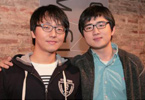
Seungdon Jung + Jungtaek Choi
Yonsei University
TRAP for Imagination
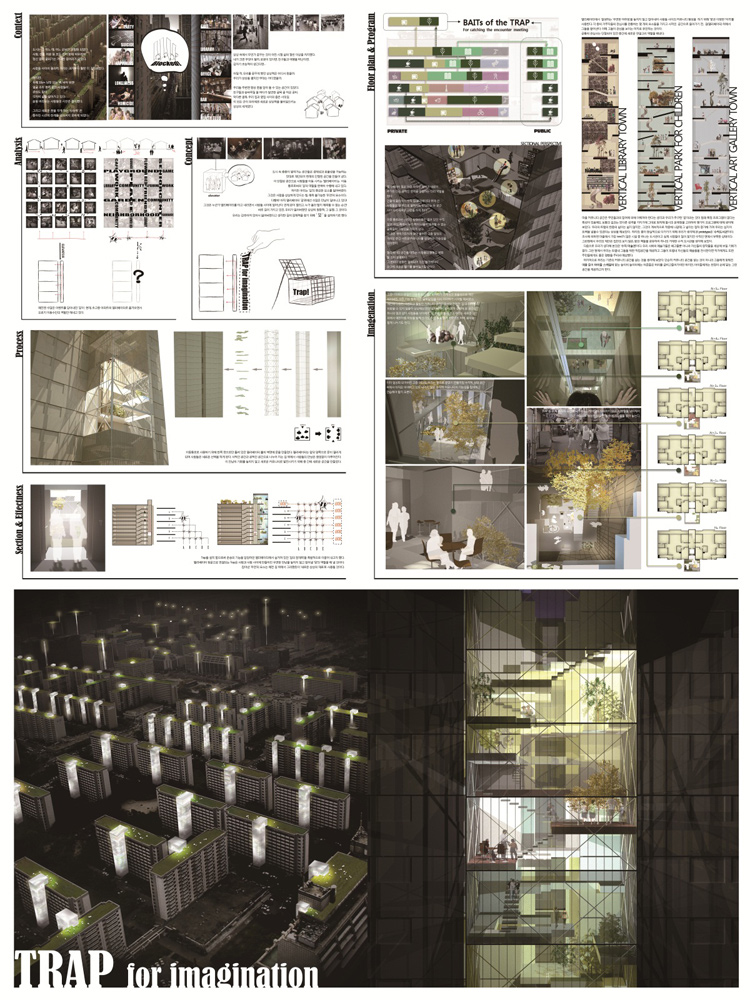 The occupancy factor of residential apartments has surpassed that of houses in Korea. Many are living in apartments. But few know who lives next door, downstairs, and upstairs from them. Why do we feel more distant from our neighbors, even though we are living closer to them than ever before? We think that the reason for this disconnection is the fundamental awkwardness of the vertical community. And we took notice of elevators, which are the only passages in the vertical direction. In the elevator, we idly watch the numbers displayed on the screen, as if it were a rule to do so. It proves that the elevator is only a means for transport. We must realize that the elevators in high-rise apartments can become very functional, economically efficient 'roads,' that could provide a variety of events and a vibrant community space. The elevator that we describe will be functioning like a trap, attracting people. On this new ‘road,’ we could share courtyards, plant flowers, and even share food with our neighbors. We should expand the possibilities of the vertical community.
The occupancy factor of residential apartments has surpassed that of houses in Korea. Many are living in apartments. But few know who lives next door, downstairs, and upstairs from them. Why do we feel more distant from our neighbors, even though we are living closer to them than ever before? We think that the reason for this disconnection is the fundamental awkwardness of the vertical community. And we took notice of elevators, which are the only passages in the vertical direction. In the elevator, we idly watch the numbers displayed on the screen, as if it were a rule to do so. It proves that the elevator is only a means for transport. We must realize that the elevators in high-rise apartments can become very functional, economically efficient 'roads,' that could provide a variety of events and a vibrant community space. The elevator that we describe will be functioning like a trap, attracting people. On this new ‘road,’ we could share courtyards, plant flowers, and even share food with our neighbors. We should expand the possibilities of the vertical community.
HONORABLE MENTION
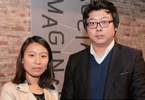
Chorok Kim + Kiseok Choi
Inha University
Non-daily Life in Daily Life

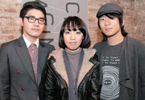
Gisoo Shim + Minsoo Kim + Soobin Park
Kookmin University
Urban Farm

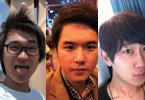
Joongtaek Son + Suckkyu Kang + Hojin Yoo
Hanbat National University
Farming_Selling_Rehabilitation
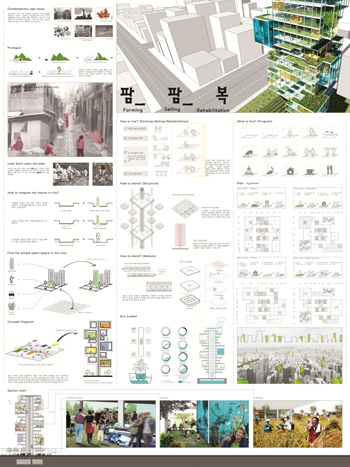
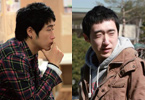
Seunghyun Kang + Seongjin Ahn
Hanbat National University
Utopian Freedom
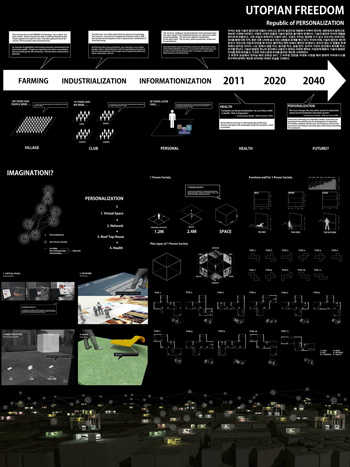

Doi Jung
Konkuk University
Alley Park
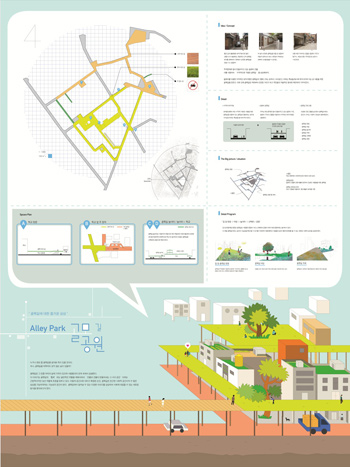
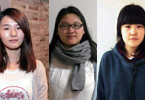
Inji Seo + Iljin Park + Yeonwoo Kim
Chungnam National University
City of Self-reproducing
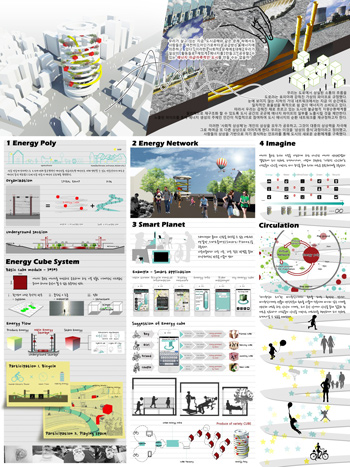
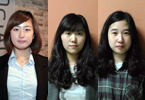
Hanbyeol Kim + Yura Yun + Jeongyi Lee
Chungnam National University
Shall We Wash?
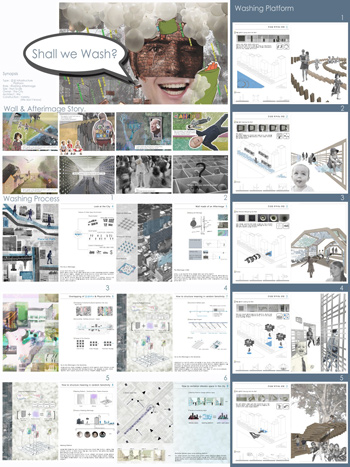
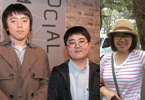
Donghyun Kim + Jeoungmok Seo + Somin Park
Daejeon University
Urban Moving Void
